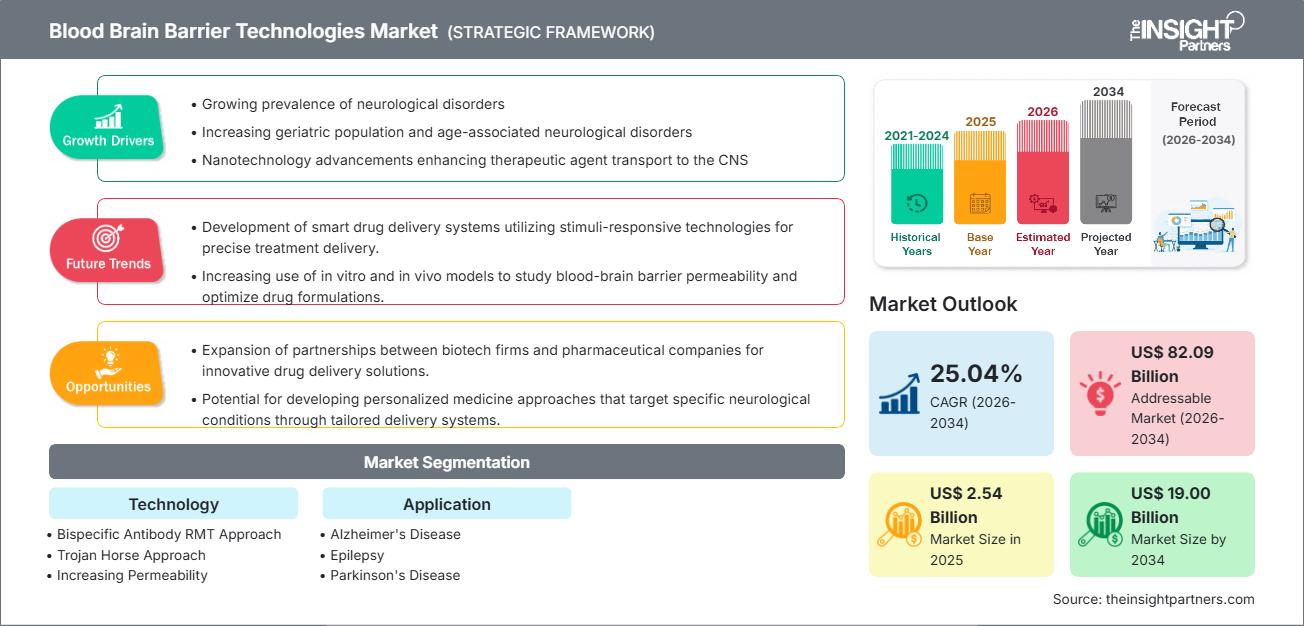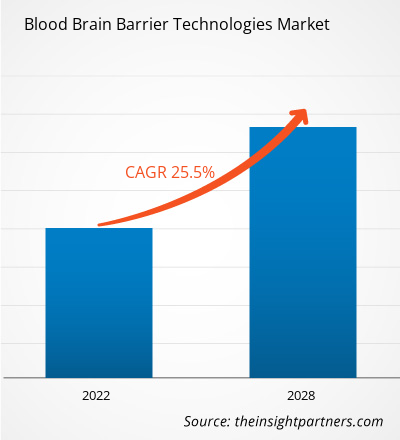Der Markt für Technologien zur Überwindung der Blut-Hirn-Schranke (BHS) wird bis 2034 voraussichtlich ein Volumen von 19,00 Milliarden US-Dollar erreichen, gegenüber 2,54 Milliarden US-Dollar im Jahr 2025. Es wird erwartet, dass der Markt im Prognosezeitraum 2026–2034 eine außergewöhnliche durchschnittliche jährliche Wachstumsrate (CAGR) von 25,04 % verzeichnen wird.
Marktanalyse der Blut-Hirn-Schranken-Technologien
Der Markt für Technologien zur Überwindung der Blut-Hirn-Schranke (BHS) verzeichnet ein explosives Wachstum, angetrieben durch die weltweit zunehmende Verbreitung schwerwiegender neurologischer Erkrankungen und die anhaltende Herausforderung, wirksame Therapeutika in das zentrale Nervensystem (ZNS) zu verabreichen. Die Marktexpansion wird primär durch massive, strategische Investitionen führender Pharma- und Biotechnologieunternehmen in die neurowissenschaftliche Forschung und Entwicklung befeuert. Diese Unternehmen setzen verstärkt auf innovative Wirkstoffverabreichungsplattformen wie die rezeptorvermittelte Transzytose (RMT) und zielgerichtete Nanopartikel, um die natürlichen Schutzmechanismen der BHS zu überwinden. Zusätzlich wird dieser Trend durch die beschleunigte Zulassung neuartiger ZNS-Therapien durch Regulierungsbehörden gefördert, wodurch die Entwicklung und Vermarktung neuer Technologien zur gezielten Wirkstoffpenetration beschleunigt wird.
Marktübersicht zu Blut-Hirn-Schranken-Technologien
Die Technologien zur Überwindung der Blut-Hirn-Schranke umfassen eine Vielzahl komplexer Methoden und Systeme, die speziell dafür entwickelt wurden, die hochselektive Endothelbarriere, die den Zugang von Medikamenten zum Gehirn und Rückenmark einschränkt, vorübergehend zu modulieren oder zu umgehen. Dieser Markt beinhaltet biologische Ansätze wie bispezifische Antikörper und Trojanische-Pferde-Vektoren, die endogene Transportwege nutzen, sowie physikalische Methoden wie fokussierter Ultraschall (FUS) und osmotische Disruption zur Steigerung der Permeabilität. Diese Technologien sind entscheidend, um das therapeutische Potenzial von Biologika mit großen Molekülen (wie Antikörpern und Peptiden) und anderen Wirkstoffen zu erschließen, die typischerweise bei Erkrankungen des zentralen Nervensystems unwirksam sind. Durch die Ermöglichung einer präzisen und erhöhten Wirkstoffkonzentration im Hirnparenchym werden diese Technologien die Behandlungsmethoden für chronische neurologische Erkrankungen revolutionieren.
Passen Sie diesen Bericht Ihren Anforderungen an.
Sie erhalten eine kostenlose Anpassung aller Berichte – einschließlich Teilen dieses Berichts, Länderanalysen und Excel-Datenpaketen – sowie attraktive Angebote und Rabatte für Start-ups und Universitäten.
Markt für Blut-Hirn-Schranken-Technologien: Strategische Einblicke

-
Ermitteln Sie die wichtigsten Markttrends dieses Berichts.Diese KOSTENLOSE Probe beinhaltet eine Datenanalyse, die von Markttrends bis hin zu Schätzungen und Prognosen reicht.
Markttreiber und Chancen im Bereich der Blut-Hirn-Schranken-Technologien
Markttreiber:
- Zunehmende Verbreitung neurologischer Erkrankungen und hoher ungedeckter Bedarf: Die weltweit steigende Inzidenz neurodegenerativer Erkrankungen, darunter Alzheimer, Parkinson und Multiple Sklerose, schafft einen dringenden und hohen Bedarf an innovativen Verabreichungssystemen, die in der Lage sind, diese Erkrankungen zu behandeln, die aufgrund der Blut-Hirn-Schranke bisher unzureichend behandelt wurden.
- Steigende Nachfrage nach gezielter Wirkstoffverabreichung an das ZNS: Die moderne pharmazeutische Forschung und Entwicklung konzentriert sich auf hochspezifische und nebenwirkungsarme Therapeutika. Technologien zur Überwindung der Blut-Hirn-Schranke ermöglichen die gezielte Verabreichung dieser Wirkstoffe, minimieren die systemische Belastung und potenzielle Nebenwirkungen und maximieren gleichzeitig die therapeutische Konzentration am Krankheitsort.
- Zunehmende Investitionen in die Biotechnologie- und pharmazeutische Forschung und Entwicklung: Es lässt sich eine deutliche Verlagerung des Forschungskapitals in die Neurowissenschaften beobachten. Regierungen und Private-Equity-Gesellschaften fördern massiv spezialisierte Biotech-Unternehmen, die sich ausschließlich auf die Entwicklung proprietärer Blut-Hirn-Schranken-Plattformen konzentrieren. Diese Plattformen reduzieren das Risiko in der Entwicklung von ZNS-Medikamenten für größere Pharmaunternehmen.
Marktchancen:
- Entwicklung nicht-invasiver Technologien zur Verbesserung der Patienten-Compliance: Technologien wie fokussierter Ultraschall (FUS), die die Blut-Hirn-Schranke temporär und präzise nicht-invasiv öffnen können, stellen ein bedeutendes Potenzial dar. FUS verspricht eine verbesserte Patienten-Compliance und ermöglicht wiederholte Dosierungen, insbesondere im Vergleich zu chirurgischen oder intraventrikulären Verabreichungsmethoden.
- Expansion in Schwellenländern mit wachsender Gesundheitsinfrastruktur: Mit der zunehmenden Reife der Volkswirtschaften im asiatisch-pazifischen Raum und in Lateinamerika steigen die Investitionen in spezialisierte Gesundheitsversorgung und der Zugang zu fortschrittlichen Biologika. Dies eröffnet neue Märkte für BBB-Plattformen, insbesondere für große, unterversorgte Patientengruppen.
- Strategische Partnerschaften zur Beschleunigung klinischer Studien und der Kommerzialisierung: Die Zusammenarbeit zwischen Biotech-Unternehmen (mit neuartigen Blut-Hirn-Schranken-Plattformen) und multinationalen Pharmaunternehmen (mit umfangreichen klinischen Entwicklungspipelines und entsprechender Kommerzialisierungskapazität) ist entscheidend. Lizenzvereinbarungen und Joint Ventures werden die Testung und Markteinführung von Medikamenten, die die Blut-Hirn-Schranke überwinden, beschleunigen.
Marktbericht zu Blut-Hirn-Schranken-Technologien: Segmentierungsanalyse
Der Markt für Blut-Hirn-Schranken-Technologien ist segmentiert nach dem Kernmechanismus, der den Arzneimitteltransport ermöglicht, und den spezifischen Krankheitsbereichen, die anvisiert werden.
Durch Technologie:
- Ansatz der bispezifischen Antikörper-Rezeptor-vermittelten Transzytose (RMT)
- Trojanisches Pferd-Ansatz
- Erhöhung der Durchlässigkeit
- Passive Diffusion
- Andere nicht-invasive Blut-Hirn-Schranken-Technologien
Auf Antrag:
- Alzheimer-Krankheit (AD)
Nach Geographie:
- Nordamerika
- Europa
- Asien-Pazifik
- Süd- und Mittelamerika
- Naher Osten und Afrika
Markt für Blut-Hirn-Schranken-Technologien: Regionale Einblicke
Die regionalen Trends und Einflussfaktoren auf den Markt für Blut-Hirn-Schranken-Technologien im gesamten Prognosezeitraum wurden von den Analysten von The Insight Partners eingehend erläutert. Dieser Abschnitt behandelt außerdem die Marktsegmente und die geografische Verteilung des Marktes für Blut-Hirn-Schranken-Technologien in Nordamerika, Europa, Asien-Pazifik, dem Nahen Osten und Afrika sowie Süd- und Mittelamerika.
Marktbericht zu Blut-Hirn-Schranken-Technologien: Umfang
| Berichtattribute | Details |
|---|---|
| Marktgröße im Jahr 2025 | 2,54 Milliarden US-Dollar |
| Marktgröße bis 2034 | 19,00 Milliarden US-Dollar |
| Globale durchschnittliche jährliche Wachstumsrate (2026 - 2034) | 25,04 % |
| Historische Daten | 2021-2024 |
| Prognosezeitraum | 2026–2034 |
| Abgedeckte Segmente |
Durch Technologie
|
| Abgedeckte Regionen und Länder |
Nordamerika
|
| Marktführer und wichtige Unternehmensprofile |
|
Marktteilnehmerdichte im Bereich der Blut-Hirn-Schranken-Technologien: Auswirkungen auf die Geschäftsdynamik verstehen
Der Markt für Blut-Hirn-Schranken-Technologien wächst rasant, angetrieben durch die steigende Nachfrage der Endverbraucher. Gründe hierfür sind unter anderem sich wandelnde Verbraucherpräferenzen, technologische Fortschritte und ein wachsendes Bewusstsein für die Vorteile der Produkte. Mit steigender Nachfrage erweitern Unternehmen ihr Angebot, entwickeln innovative Lösungen, um den Verbraucherbedürfnissen gerecht zu werden, und nutzen neue Trends, was das Marktwachstum zusätzlich beflügelt.

- Verschaffen Sie sich einen Überblick über die wichtigsten Akteure im Markt für Blut-Hirn-Schranken-Technologien
Marktanteilsanalyse der Blut-Hirn-Schranken-Technologien nach Regionen
Nordamerika hält den größten Marktanteil, während der asiatisch-pazifische Raum im Prognosezeitraum voraussichtlich das schnellste Wachstum verzeichnen wird. Die globale Marktführerschaft wird maßgeblich durch die regionale Konzentration von Forschung und Entwicklung, geistige Eigentumsrechte und regulatorische Rahmenbedingungen geprägt, die risikoreiche, aber potenziell sehr ertragreiche Therapien des zentralen Nervensystems begünstigen. Nachfolgend finden Sie eine Zusammenfassung der Marktanteile und Trends nach Regionen:
Nordamerika
- Marktanteil: Dominiert den Markt für Blut-Hirn-Schranken-Technologien und hält den größten Marktanteil aufgrund der höchsten Konzentration führender Pharmaunternehmen, einer umfangreichen F&E-Infrastruktur und erheblicher Risikokapitalfinanzierung für Biotech-Startups, die sich auf BBB-Plattformen spezialisieren.
- Wichtigste Treiber: Umfangreiche Entwicklung von Medikamentenpipelines für die Alzheimer- und Parkinson-Krankheit.
- Trends: Starker Fokus auf die klinische Umsetzung fortschrittlicher RMT- und bispezifischer Antikörpertechnologien in spätphasige Studien.
Europa
- Marktanteil: Verfügt über einen bedeutenden Marktanteil, der durch starke staatlich unterstützte Forschungsinitiativen (z. B. Horizon Europe-Förderung für Neurowissenschaften) und eine zunehmende Belastung durch ZNS-Erkrankungen in der gesamten Region bedingt ist.
- Wichtigste Einflussfaktoren: Intensive akademische Zusammenarbeit zwischen Institutionen und Industriepartnern.
- Trends: Zunehmende Anwendung nicht-invasiver physikalischer Techniken zur Modulation der Blut-Hirn-Schranke, insbesondere fokussierter Ultraschall, der in europäischen Forschungskrankenhäusern getestet wird.
Asien-Pazifik
- Marktanteil: Die Region mit dem schnellsten Wachstum, aufgrund der rasant steigenden Investitionen in die Gesundheitsforschung, einer wachsenden Patientenpopulation für neurologische Erkrankungen und der Einrichtung spezialisierter Biotechnologiezentren.
- Wichtigste Treiber: Schnelles Wachstum privater Biotechnologieunternehmen, die sich auf Innovationen im Bereich der Blut-Hirn-Schranke in der Frühphase konzentrieren.
- Trends: Hohe Akzeptanz von Partnerschaftsmodellen, bei denen lokale Biotech-Unternehmen mit westlichen Pharmaunternehmen zusammenarbeiten, um gemeinsam BBB-Medikamente zu entwickeln, die auf regionale Märkte zugeschnitten sind.
Süd- und Mittelamerika
- Marktanteil: Aufstrebender Markt mit noch jungen, aber wachsenden Chancen, vor allem getrieben durch die Expansion des Pharmasektors und den verbesserten Zugang zu spezialisierter Versorgung.
- Wichtigste Triebkräfte: Öffentlich-private Gesundheitspartnerschaften mit dem Ziel, Ungleichheiten in der neurologischen Gesundheitsversorgung zu beseitigen.
- Trends: Erste Anwendung kosteneffektiver Trojaner-Ansätze und generisches Repurposing unter Verwendung passiver Diffusionsverstärker.
Naher Osten und Afrika
- Marktanteil: Ein sich entwickelnder Markt mit hohem Wachstumspotenzial, unterstützt durch erhebliche staatliche Investitionen in den Ausbau der Gesundheitsinfrastruktur und den Fokus auf die Einrichtung medizinischer Forschungs- und Entwicklungszentren.
- Wichtigste Einflussfaktoren: Nationale E-Health-Strategien mit Schwerpunkt auf spezialisierter Versorgung, einschließlich Neurologie.
- Trends: Implementierung spezialisierter neurowissenschaftlicher Forschungsprogramme, die Zugang zu modernsten Blut-Hirn-Schranken-Technologien erfordern, vor allem durch Kooperationen mit globalen Marktführern.
Marktteilnehmerdichte im Bereich der Blut-Hirn-Schranken-Technologien: Auswirkungen auf die Geschäftsdynamik verstehen
Der Markt für Blut-Hirn-Schranken-Technologien ist hochdynamisch und durch eine Mischung aus großen Pharmaunternehmen und kleinen, spezialisierten Biotech-Plattformentwicklern gekennzeichnet. Im Mittelpunkt des Wettbewerbs steht nicht nur die Vermarktung des fertigen Medikaments, sondern vor allem der Nachweis der überlegenen Sicherheit, Wirksamkeit und Skalierbarkeit der firmeneigenen Wirkstoffverabreichungstechnologie.
Dieses wettbewerbsintensive Umfeld zwingt die Anbieter dazu, sich durch Folgendes zu differenzieren:
- Validierte Applikationsplattformen: Der primäre Wettbewerbsvorteil liegt im Nachweis der klinischen Sicherheit und Wirksamkeit der BBB-Technologie in frühen Studienphasen (Phase I und II).
- Strategische Lizenzierung und Partnerschaften: Kleinere Biotech-Unternehmen konzentrieren sich darauf, ihre proprietäre BBB-Technologie an große Pharmaunternehmen zu lizenzieren, um die Entwicklung zu finanzieren und eine breite Marktabdeckung zu gewährleisten.
- Gezielte Ansteuerung spezifischer Rezeptoren: Entwicklung bispezifischer Antikörper der nächsten Generation, die Off-Target-Effekte minimieren und die Aufnahme ins Gehirn über neuartige oder bisher wenig genutzte Blut-Hirn-Schranken-Rezeptoren maximieren.
- Integration nicht-invasiver Modalitäten: Fokus auf die Integration physikalischer Disruptionstechnologien (wie FUS) mit spezifischen pharmazeutischen Kandidaten, um eine vollständige, nicht-chirurgische Behandlungslösung anzubieten.
Die wichtigsten Unternehmen auf dem Markt für Blut-Hirn-Schranken-Technologien sind:
- Teva Pharmaceutical Industries Ltd.
- F. Hoffmann-La Roche Ltd.
- Eli Lilly and Company
- Pfizer, Inc.
- Johnson and Johnson Services, Inc.
- Bristol-Myers Squibb Company
- Bioasis Technologies Inc.
- Fabre-Kramer Pharmaceuticals, Inc.
- Abliva AB
Hinweis: Die oben aufgeführten Unternehmen sind nicht in einer bestimmten Reihenfolge geordnet.
Marktneuigkeiten und aktuelle Entwicklungen im Bereich der Blut-Hirn-Schranken-Technologien
- F. Hoffmann-La Roche AG: Roche hat seine patentierte Brainshuttle™-Technologie entwickelt, die es großen therapeutischen Molekülen wie Antikörpern und Oligonukleotiden ermöglicht, die Blut-Hirn-Schranke zu überwinden. Diese Plattform wird derzeit klinisch für neurodegenerative und seltene Erkrankungen des zentralen Nervensystems evaluiert und stärkt Roches führende Position im Bereich gezielter Wirkstofftransportlösungen für das Gehirn.
-
Pfizer, Inc.: Pfizer entwickelt innovative Ansätze zur Überwindung der Blut-Hirn-Schranke, darunter AAV-Vektoren und Nanopartikel-basierte Verabreichungssysteme. Diese Technologien zielen darauf ab, die Behandlungsmöglichkeiten für Hirnmetastasen und seltene neurologische Erkrankungen zu verbessern und stehen im Einklang mit Pfizers strategischem Fokus auf Gentherapie und Onkologie.
- Johnson & Johnson Services, Inc.: Johnson & Johnson hob seine Zusammenarbeit mit VECT-HORUS hervor, einer Plattform, die die Wirkstoffverabreichung durch die Blut-Hirn-Schranke ermöglicht. Die Technologie wird auch für die Behandlung und Diagnose verschiedener neurodegenerativer Erkrankungen erforscht und unterstreicht damit das Engagement von J&J im Bereich der ZNS-Therapeutika.
Marktbericht zu Blut-Hirn-Schranken-Technologien: Abdeckung und Ergebnisse
Der Bericht „Marktgröße und Prognose für Technologien zur Erforschung der Blut-Hirn-Schranke (2021–2034)“ bietet eine detaillierte Analyse des Marktes, die folgende Bereiche abdeckt:
- Marktgröße und Prognose für Blut-Hirn-Schranken-Technologien auf globaler, regionaler und Länderebene für alle wichtigen Marktsegmente, die in den Geltungsbereich fallen.
- Markttrends im Bereich der Blut-Hirn-Schranken-Technologien sowie Marktdynamiken wie Treiber, Hemmnisse und wichtige Chancen.
- Detaillierte PEST- und SWOT-Analyse.
- Marktanalyse der Blut-Hirn-Schranken-Technologien mit Fokus auf wichtige Markttrends, globale und regionale Rahmenbedingungen, Hauptakteure, regulatorische Bestimmungen und aktuelle Marktentwicklungen.
- Branchenlandschafts- und Wettbewerbsanalyse mit Fokus auf Marktkonzentration, Heatmap-Analyse, prominente Akteure und aktuelle Entwicklungen auf dem Markt für Blut-Hirn-Schranken-Technologien.
- Detaillierte Unternehmensprofile.
- Historische Analyse (2 Jahre), Basisjahr, Prognose (7 Jahre) mit CAGR
- PEST- und SWOT-Analyse
- Marktgröße Wert/Volumen – Global, Regional, Land
- Branchen- und Wettbewerbslandschaft
- Excel-Datensatz
Aktuelle Berichte
Erfahrungsberichte
Grund zum Kauf
- Fundierte Entscheidungsfindung
- Marktdynamik verstehen
- Wettbewerbsanalyse
- Kundeneinblicke
- Marktprognosen
- Risikominimierung
- Strategische Planung
- Investitionsbegründung
- Identifizierung neuer Märkte
- Verbesserung von Marketingstrategien
- Steigerung der Betriebseffizienz
- Anpassung an regulatorische Trends






















 Kostenlose Probe anfordern für - Markt für Blut-Hirn-Schranken-Technologien
Kostenlose Probe anfordern für - Markt für Blut-Hirn-Schranken-Technologien